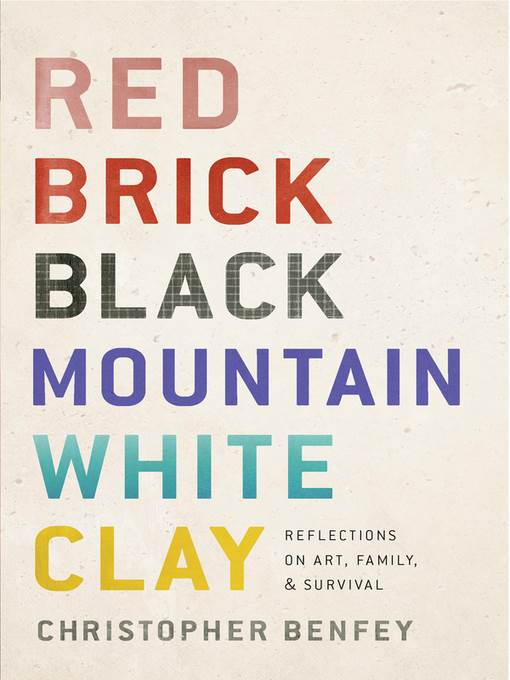
Red Brick, Black Mountain, White Clay
Reflections on Art, Family, and Survival
کتاب های مرتبط
- اطلاعات
- نقد و بررسی
- دیدگاه کاربران
نقد و بررسی

November 21, 2011
As Mt. Holyoke English professor Benfey (A Summer of Hummingbirds) observes in his combined meditation on art in America and family history, “Sometimes, the shortest path between two points is serpentine.” This aspect both intrigues and frustrates. The three-part title refers to his mother’s red-clay world of rural North Carolina; his father’s involvement with Black Mountain College, run by his uncle, artist Josef Albers; and from the 18th-century search for the so-called Cherokee clay of the North Carolina outback for making fine porcelain. These elements are mixed and remixed in unexpected ways. Whereas the results are often charming and even enchanting, the book can be exhausting: not unlike the long essays of the New York Review of Books, for which Benfey writes. His book is certainly constructed with skill around an exploration of the meander (originally a design element on a Greek vase), as central to this narrative as the Shield of Achilles is to Homer’s. Benfey’s own meander ends with Whistler’s mother (like Benfey’s, a North Carolinian). The title of Whistler’s portrait of his mother, Arrangement in Grey and Black, might serve as the title of this fragmented memoir. 39 photos; 16 pages of color illus.

February 1, 2012
From Benfey (English/Mount Holyoke Coll.; A Summer of Hummingbirds: Love, Art, and Scandal in the Intersecting Worlds of Emily Dickinson, Mark Twain, Harriet Beecher Stowe, and Martin Johnson Heade, 2008, etc.), a lyrical but unsentimental family memoir, taking in art, memory and time. The circumstances of the author's youth are not entirely rare: On one side, the bloodline extends far back into the American colonial past, on the other to just a few decades in the lives of refugees and exiles. Thus our narrator, as a boy, found himself at a basketball awards dinner where trophies were followed by a father-and-son game, his German-accented father dressed in coat and tie, awkward. "He could no more play basketball than fly to Mars," writes Benfey. However, his American grandfather was a more practical sort, a bricklayer who once traveled from North Carolina to the Benfey home in Indiana just to lay in a mantelpiece, showing his grandson how to apply mortar, "spread with a pointed trowel like icing on a cake." Disappointments gave way to understandings as the years passed. Forging links to a deeper past, the author looks at great naturalist William Bartram and explores the hidden past of his parents--he discovered, for instance, that his mother had been engaged to be married before meeting his father, a fact that would rattle any sensitive kid. Benfey's account, as he puts it, is more geological than chronological, bound together by the clay worked by his artful ancestors and, in one extended section, by the against-the-grain teaching that took place at Black Mountain College in North Carolina courtesy of a small troupe of brilliant European exiles. "Black Mountain had seemed almost a mythical place during our upbringing, a tether linking our flat Midwestern childhood to the vivid summers of artistic innovation and adventure," he writes--how many other childhood homes had a painting by Josef Albers in the dining room? Lively, intelligent and interesting--a look inside not just a single family, but also an entire artistic tradition now largely forgotten.
COPYRIGHT(2012) Kirkus Reviews, ALL RIGHTS RESERVED.

October 15, 2011
Since his mother traces her lineage back to Colonial craftsmen and his father fled Nazi Europe with his uncle and aunt, Bauhaus artists Josef and Anni Albers (Josef eventually headed up Carolina's visionary Black Mountain College), Benfey really can look at his family to tell the larger story of American art. Exactly the sort of far-reaching memoir I like.
Copyright 2011 Library Journal, LLC Used with permission.

Starred review from March 1, 2012
A connoisseur of unlikely artistic, cultural, and familial connections, Benfey, author of the prizewinning A Summer of Hummingbirds (2008), spins a grand web out of his own fascinating lineage. His artist mother, Rachel, came from a North Carolina family of brick makers and bricklayers in a region rich in not only the red clay that masons and earthenware potters treasured but also the rare white clay coveted by the famous English ceramicist Josiah Wedgwood, who launched risky expeditions to secure this precious substance in his quest to discover the secret of fine Chinese porcelain. Born to wealth and status, Benfey's Jewish father, Otto, became a refugee from Nazi Germany, an organic chemistry professor, and, after Hiroshima, a Quaker. Otto's aunt, the famous textile artist Anni Albers, and her husband, painter Josef Albers, two essential Bauhaus figures, reached America before him and, as Benfey so insightfully elucidates, helped make the short-lived but immensely influential Black Mountain College an Appalachian artistic hotbed. A vivid and resourceful storyteller, Benfey recounts his own youthful apprenticeship in a Japanese pottery village and chronicles the adventures of his intrepid ancestor, naturalist and explorer William Bartram. In this revelatory mosaic of lives, Benfey reclaims radiant swathes of history, traces hidden links between remarkable innovators, and celebrates serendipity, resilience, and the refulgence of art.(Reprinted with permission of Booklist, copyright 2012, American Library Association.)

























دیدگاه کاربران